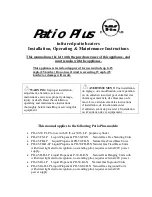
Page 22
LAARS Heating Systems
4.
Now that the heater is firing, use the blower
damper to readjust the venturi inlet pressure
according to the installation’s altitude in Table
11 (+1.6"w.c. at sea level).
Elevation
Venturi Inlet
Gas
Throat
Ft.
Pressure
Pressure
Differential
(Blue Tap)
Offset
Pressure
“WC H
2
0”
“WC H
2
0”
“WC H
2
0”
SEA LEVEL
+1.6
+0.4
+2.6
1000
+1.5
+0.4
+2.5
2000
+1.5
+0.4
+2.4
3000
+1.4
+0.4
+2.3
4000
+1.4
+0.3
+2.2
5000
+1.3
+0.3
+2.2
6000
+1.3
+0.3
+2.1
7000
+1.2
+0.3
+2.0
8000
+1.2
+0.3
+1.9
9000
+1.1
+0.3
+1.9
10000
+1.1
+0.3
+1.8
Table 11. Venturi Pressure Settings - Propane Gas.
5.
Leaving the positive side of the manometer
connected to the venturi inlet tap (blue), connect
the negative side of the manometer to the shutoff
valve on the gas orifice tap (red). Open the
shutoff valve to take a pressure reading. This
reading is called the gas pressure offset. Using
the regulator only, adjust the gas pressure offset
according to the installation's altitude in Table 11
(+0.4" w.c. at sea level). REPLACE THE
REGULATOR CAP BEFORE TAKING GAS
PRESSURE READINGS. Turn the regulator
screw clockwise to decrease the gas pressure
offset, turn the regulator screw counter-
clockwise to increase the offset.
6.
Using the toggle switch, turn the heater off. Turn
the heater back on and check the gas pressure
offset after the heater has fired. If the gas offset
pressure is not according to Table 11, adjust the
regulator as needed.
7.
While the heater is still running, close the shutoff
valve on the gas orifice tap (red), then remove
the manometer hose from the shutoff valve.
Connect the negative side of the manometer to
the shutoff valve on the venturi throat tap
(yellow). This reading is called the venturi throat
differential pressure and should appear according
to altitude in Table 10 (+2.6" w.c. at sea level). If
it does not appear according to Table 11, contact
a qualified service technician.
After setting all pressures, turn the heater off and
replace each shutoff valve with the factory installed
threaded plugs. The venturi has now been adjusted for
proper operation.
SECTION 4.
Maintenance
4.1 General Instructions
1.
Oil the water circulating pump in accordance
with the manufacturer's instructions.
2.
Oil the blower motor bearings every 6 months.
3.
If a strainer is used in a pressure reducing valve
or in the piping, clean it every 6 months in
accordance with the manufacturer's instructions.
4.
At startup and every 6 months after, look at the
main burner flame for proper performance. The
burner should not require maintenance in normal
operation. If any malfunction indicates that the
burner needs service (e.g., a flame that is yellow,
or entire burner surface glowing red), call a
professional service technician. Flame
characteristics may be inspected during the first
30 seconds after ignition. Characteristics of a
good flame are:
a.
Blue flame color
b.
Dark-colored burner surface with
occasional glowing fibers on surface.
NOTE:
After 30 seconds of operation the combustion
chamber will heat up and prevent reliable flame
observation.
5.
Inspect the venting system for blockage, leakage,
and corrosion at least once a year.
6.
Keep the heater area clear of combustible
material, gasoline, and other flammable liquids
and vapors.
7.
Be sure all combustion air and ventilation
openings are not blocked.
8.
After installation and first startup, check the heat
exchanger for black carbon soot buildup after the
following periods of operation: 24 hours, 7 days,
30 days, 90 days, and once every 6 months
thereafter.
4.2 Heat Exchanger
Black carbon soot buildup on the external
surfaces of the heat exchanger is caused by one or
more of the following: incomplete combustion,
combustion air problems, venting problems and heater
short cycling. As soon as any buildup is seen, correct
the cause of the buildup.
Scale can build up on the
inner surface of the heat exchanger tubes and
restrict the water flow
. Inspect the heat exchanger in
accordance with Section 4.2.1.
If the heat exchanger needs cleaning see
Section 4.2.2.
OUT OF
PRODUCTION











































